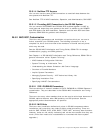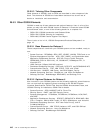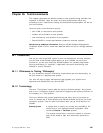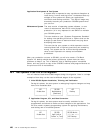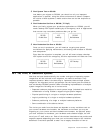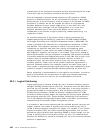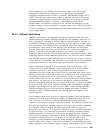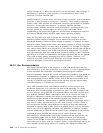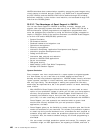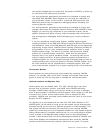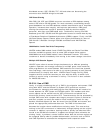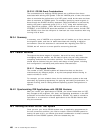Recent advances in the PR/SM LIC have solved some of the real storage
management difficulties encountered in the past concerning assigning
contiguous storage chunks to LPARs. In addition, ESCON Multi Image Facility
(EMIF) channels have reduced the number of physical channels that must be
installed to support multiple partitions by allowing for the sharing of physical
channels between partitions. However, notwithstanding these recent
advancements, the definition of partitions still requires the dedication of real
hardware resource. As a consequence, logically partitioning a CEC will typically
involve the purchase of more hardware than would be required to run the CEC in
single image mode.
26.3.2 Software Partitioning
Software partitioning is accomplished through the installation and use of the
VM/ESA operating system. VM/ESA manages the real hardware resources of a
CEC, and makes it available to software defined virtual machines. The user of
the VM/ESA operating system is provided with a virtual machine at logon time,
and accesses all real hardware resources through that virtual machine. VM/ESA
provides each virtual machine with storage, CPU resources, and peripheral
devices. Often these resources are virtual (hence the name of the operating
system). This means that peripheral devices, for example, are software
constructs that emulate the real peripheral devices, and provide access to real
underlying devices without dedicating that device to a particular virtual machine.
The VM/ESA operating system manages the real devices such that the integrity
of the devices is maintained, and individual virtual machines are prevented from
accessing or destroying resources being used by another virtual machine.
Virtual machines are defined in a flat file known as the VM Directory. Each
virtual machine is represented by a stanza within this file. A virtual machine
definition consists of a name for the virtual machine (user ID) along with
statements that define how many virtual CPUs are allocated, how much virtual
storage is allocated, what virtual devices are allocated and their characteristics,
along with privileges given to the virtual machine. Since the resources of a
virtual machine are not real, the number of virtual machines that can be defined
and active at any one time is not limited to the physical resources available.
Using the example presented above for logical partitioning, it would be possible
to log on all five of the virtual machines defined (each with 500MB of storage
defined), even though the real CEC only has 1GB of central storage available.
VM/ESA manages the use of real memory by paging real frames of central
storage to slots on DASD based upon the use and reference patterns of the
virtual machines.
Since software partitioning involves an operating system, some real hardware
resources will need to be allocated to support this operating system. Thus the
real resources of the CEC will now be distributed among three operating
systems in our migration scenario instead of just two. It is possible however, to
minimize the impact that VM/ESA has upon use of the real hardware resources.
For example, instead of having VM/ESA create virtual DASD devices for a
particular virtual machine, it is possible to dedicate certain real DASD devices to
a virtual machine. This removes the simulation overhead incurred by having
VM/ESA maintain a virtual device, and allows the virtual machine complete
control over the particular DASD device. While the DASD device is dedicated to
a particular virtual machine it is unavailable for use by any other virtual
machine. It is also possible to dedicate central storage to a particular virtual
machine. When this is done, it avoids the overhead of having VM/ESA perform
paging operations, and allows the guest to occupy and manage a portion of real
Chapter 26. Test Environments 423



